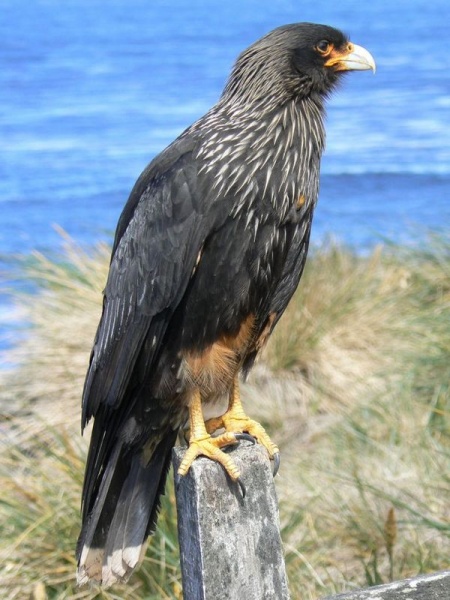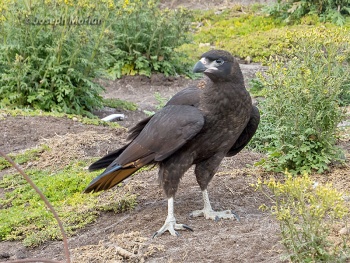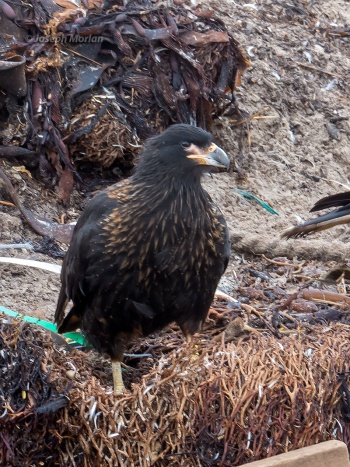| (37 intermediate revisions by 5 users not shown) | |||
| Line 1: | Line 1: | ||
| − | ;Phalcoboenus australis | + | ;[[:category:Phalcoboenus|Phalcoboenus]] australis |
| − | [[Image:Striated Caracara11a.jpg|thumb| | + | [[Image:Striated Caracara11a.jpg|thumb|450px|right|'''Adult.'''<br /> Photo by {{user|Vernon+Lundy|Vernon Lundy}}<br />[[Falkland Islands]] Nov 2006.]] |
==Identification== | ==Identification== | ||
| − | + | [[Image:StriatedCaracaraIMG_1227.jpg|thumb|350px|right|'''Juvenile.'''<br /> Photo by {{user|jmorlan|Joseph Morlan}}<br />Carcass Island,[[Falkland Islands]] | |
| − | + | 2 March 2018.]] | |
| − | + | '''1st year (juvenile)'''<br /> | |
| − | + | *Dark brownish-black, nape with [[Dictionary G-L#I|iridescent]] brown flecks | |
| − | + | *Tail with gold sheen | |
| − | + | *Paler [[Topography#Wings|primaries]] with bluish trim | |
| + | *Pale grey legs, feet and [[Topography#Heads|cere]] | ||
| + | *Bill mostly dark<br /> | ||
| + | '''2nd year<br />''' | ||
| + | * Primaries more rufous | ||
| + | * Pale [[Topography#Beaks|culmen]]<br /> | ||
| + | '''3rd year <br />''' | ||
| + | * Buff-brown streaking extends to breast | ||
| + | * Legs, feet and cere yellow-orange | ||
| + | * Bill paler, blue-gray<br /> | ||
| + | '''4th year <br />''' | ||
| + | * Streaks grayish, less brown | ||
| + | * Thigh feathers rufous | ||
| + | * Tail white tipped<br /> | ||
| + | '''5th year <br />''' | ||
| + | * Streaking light gray | ||
| + | * Tail tip with white bars | ||
| + | * Legs, feet and cere bright yellow-orange | ||
| + | * Bill pale blue-gray<br /> | ||
| + | Streaking becomes whiter as age progresses.<sup>[[#References|[1]]]</sup> | ||
==Distribution== | ==Distribution== | ||
| − | [[Falkland Islands]] and [[Tierra del Fuego]]. In decline in both areas and in the Falklands restricted to West Falkland and islands off the west coast, in the south of Falkland Sound and Sea Lion Island and | + | [[Falkland Islands]] and [[Tierra del Fuego]]. In decline in both areas and in the Falklands restricted to West Falkland and islands off the west coast, in the south of Falkland Sound and Sea Lion Island and Beauchene Islands south of East Falkland. In Tierra del Fuego found on the southern coast and on islands in the south of the Beagle Channel. Resident. |
==Taxonomy== | ==Taxonomy== | ||
| − | + | [[Image:StriatedCaracaraIMG 1630.jpg|thumb|350px|right|'''Second year'''.<br /> Photo by {{user|jmorlan|Joseph Morlan}}<br />Saunders Island,[[Falkland Islands]] 2 March 2018]] | |
| + | This is a [[Dictionary_M-S#M|monotypic]] species <sup>[[#References|[2]]][[#References|[4]]]</sup> | ||
==Habitat== | ==Habitat== | ||
| − | Found on shorelines and scavenges in seabird colonies. | + | Found on shorelines and often scavenges in seabird colonies. |
==Behaviour== | ==Behaviour== | ||
| − | + | ====Diet==== | |
| + | Feeds primarily on carrion, adult and young sea birds, particularly penguins; but may also kill newborn lambs or disabled sheep. Their diet includes invertebrates which they can dig out with their strong claws. | ||
| + | ====Breeding==== | ||
| + | They make a nest from sticks and grass and when possible line it with wool. The clutch contains up to 4 eggs. | ||
| + | |||
| + | ==Gallery== | ||
| + | Click on photo for larger image | ||
| + | <gallery> | ||
| + | Image:IGP0078.jpg|'''Third year'''<br />Photo by {{user|StrikingSlug|StrikingSlug}}<br />Carcass Island,[[Falkland Islands]] 9 Nov 2009 | ||
| + | Image:EBFStriatedCaracaraLowen966.jpg|'''Juvenile in flight'''<br />Photo by {{user|JCL|James C Lowen}}<br />Carcass Island,[[Falkland Islands]] March 2007 | ||
| + | Image:Striated_Caracara12b.jpg|'''Adult in flight'''<br />Photo by {{user|Vernon+Lundy|Vernon Lundy}}<br />Sea Lion Island, [[Falkland Islands]] October 2006 | ||
| + | </gallery> | ||
| + | |||
| + | ==References== | ||
| + | #[http://www.avibirds.com/html/falcons/Striated_Caracara.html Avibirds] | ||
| + | #Bierregaard, R.O., Jr, Kirwan, G.M. & Garcia, E.F.J. (2018). Striated Caracara (''Phalcoboenus australis''). In: del Hoyo, J., Elliott, A., Sargatal, J., Christie, D.A. & de Juana, E. (''eds.''). Handbook of the Birds of the World Alive. Lynx Edicions, Barcelona. (retrieved from https://www.hbw.com/node/53192 on 16 May 2018). | ||
| + | #BirdLife International. 2016.'' Phalcoboenus australis''. The IUCN Red List of Threatened Species 2016: e.T22696247A93551504. http://dx.doi.org/10.2305/IUCN.UK.2016-3.RLTS.T22696247A93551504.en. Downloaded on 16 May 2018. | ||
| + | #{{Ref-Clements6thAug17}}#{{Ref-Jaramillo03}}#Wikipedia | ||
| + | #BF Member observations | ||
| + | {{ref}} | ||
| − | |||
==External Links== | ==External Links== | ||
{{GSearch|Phalcoboenus+australis}} | {{GSearch|Phalcoboenus+australis}} | ||
| − | [[Category:Birds]][[category: | + | [[Category:Birds]][[category:Phalcoboenus]] |
Latest revision as of 17:01, 21 May 2018
- Phalcoboenus australis
Identification
1st year (juvenile)
- Dark brownish-black, nape with iridescent brown flecks
- Tail with gold sheen
- Paler primaries with bluish trim
- Pale grey legs, feet and cere
- Bill mostly dark
2nd year
- Primaries more rufous
- Pale culmen
3rd year
- Buff-brown streaking extends to breast
- Legs, feet and cere yellow-orange
- Bill paler, blue-gray
4th year
- Streaks grayish, less brown
- Thigh feathers rufous
- Tail white tipped
5th year
- Streaking light gray
- Tail tip with white bars
- Legs, feet and cere bright yellow-orange
- Bill pale blue-gray
Streaking becomes whiter as age progresses.[1]
Distribution
Falkland Islands and Tierra del Fuego. In decline in both areas and in the Falklands restricted to West Falkland and islands off the west coast, in the south of Falkland Sound and Sea Lion Island and Beauchene Islands south of East Falkland. In Tierra del Fuego found on the southern coast and on islands in the south of the Beagle Channel. Resident.
Taxonomy
This is a monotypic species [2][4]
Habitat
Found on shorelines and often scavenges in seabird colonies.
Behaviour
Diet
Feeds primarily on carrion, adult and young sea birds, particularly penguins; but may also kill newborn lambs or disabled sheep. Their diet includes invertebrates which they can dig out with their strong claws.
Breeding
They make a nest from sticks and grass and when possible line it with wool. The clutch contains up to 4 eggs.
Gallery
Click on photo for larger image
Third year
Photo by StrikingSlug
Carcass Island,Falkland Islands 9 Nov 2009Juvenile in flight
Photo by James C Lowen
Carcass Island,Falkland Islands March 2007Adult in flight
Photo by Vernon Lundy
Sea Lion Island, Falkland Islands October 2006
References
- Avibirds
- Bierregaard, R.O., Jr, Kirwan, G.M. & Garcia, E.F.J. (2018). Striated Caracara (Phalcoboenus australis). In: del Hoyo, J., Elliott, A., Sargatal, J., Christie, D.A. & de Juana, E. (eds.). Handbook of the Birds of the World Alive. Lynx Edicions, Barcelona. (retrieved from https://www.hbw.com/node/53192 on 16 May 2018).
- BirdLife International. 2016. Phalcoboenus australis. The IUCN Red List of Threatened Species 2016: e.T22696247A93551504. http://dx.doi.org/10.2305/IUCN.UK.2016-3.RLTS.T22696247A93551504.en. Downloaded on 16 May 2018.
- Clements, J. F., T. S. Schulenberg, M. J. Iliff, D. Roberson, T. A. Fredericks, B. L. Sullivan, and C. L. Wood. 2017. The eBird/Clements checklist of birds of the world: v2017, with updates to August 2017. Downloaded from http://www.birds.cornell.edu/clementschecklist/download/
- Jaramillo, A. 2003. Birds of Chile. Princeton & Oxford: Princeton Univ. Press. ISBN 978-0691117409
- Wikipedia
- BF Member observations
Recommended Citation
- BirdForum Opus contributors. (2024) Striated Caracara. In: BirdForum, the forum for wild birds and birding. Retrieved 19 April 2024 from https://www.birdforum.net/opus/Striated_Caracara









